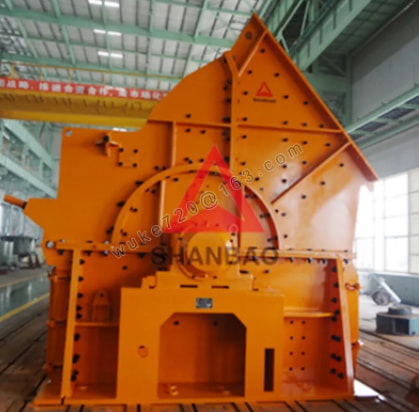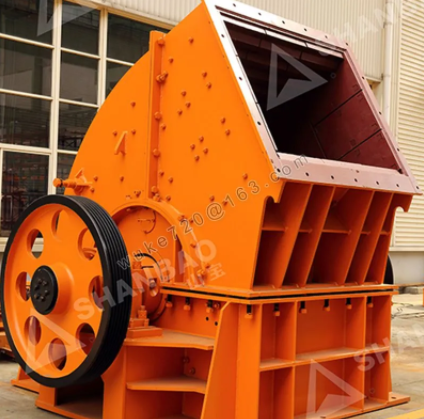The Differences Between Impact Crusher And Hammer Crusher
Aug. 07, 2025
Both impact crushers and hammer crushers are widely used stone-crushing machines, typically serving as the primary crusher in stone crushing plants or mineral processing facilities. While they may look similar at first glance, they differ significantly in design and operation. So, which one is better?
1. Working Principle
Hammer Crusher:
The hammer crusher mainly consists of the machine body, transmission device, and rotor. The transmission device includes a triangular belt, motor, and pulley. The rotor is equipped with multiple hammerheads coated with wear-resistant material to reduce wear and tear. During operation, the rock or ore is crushed by the high-speed rotating hammerheads. The crushed material then rebounds to the impact plate for further crushing through repeated high-speed impacts. This process repeats multiple times to achieve the desired size reduction.
Impact Crusher:
The impact crusher comprises a body frame, transmission mechanism, rotor, and impact plates. The body frame is divided into upper and lower parts connected by bolts. Inside the crushing chamber, the impact plate is suspended. The rotor carries the plate hammers, which are the main wear parts. The material first strikes the rotating hammerheads and then is propelled at high speed toward the impact plate. It is then thrown to the opposite impact plate along a tangent direction for further crushing. This cycle repeats until the material is reduced to the required size.
2. Appearance, Applicable Materials, and Discharge Size
Appearance:
There are two main types of hammer crushers: small hammer crushers and heavy hammer crushers. The heavy hammer crusher resembles an impact crusher in appearance, especially from the front. However, their backs differ noticeably — the hammer crusher has a smooth, curved rear, while the impact crusher features a more angular back.
Applicable Materials:
Hammer crushers are best suited for crushing medium-hardness materials with a compressive strength below 200 MPa. In contrast, impact crushers are ideal for processing brittle materials with compressive strengths up to 350 MPa, such as granite, limestone, and concrete.
Discharge Size:
The hammer crusher can accept feed sizes ranging from 600 to 1800 mm, producing output material smaller than 25 mm. The impact crusher handles feed sizes up to 500 mm, with a generally finer discharge size depending on the settings.
3. Maintenance and Wear of Spare Parts
Maintenance:
Impact crushers feature several plate hammers mounted on the rotor, making maintenance relatively straightforward and convenient. In contrast, hammer crushers have numerous hammer heads — sometimes dozens — which makes replacement more time-consuming and labor-intensive. Additionally, the varying shapes and sizes of the plate hammers and hammer heads complicate the spare parts replacement process.
Wear and Damage:
The wear on impact crusher plate hammers primarily occurs on the side facing the material. When operating at normal rotor speed, material strikes the front surface of the plate hammer, while the back and sides experience minimal wear. This focused wear pattern allows for a high metal utilization rate of approximately 45% to 48%.
On the other hand, hammer crusher hammer heads experience wear on multiple surfaces — top, front, back, and sides. This results in more severe wear overall, with a lower metal utilization rate of about 25%, leading to more frequent replacements.
4. Advantages
Advantages of Hammer Crushers:
High Crushing Efficiency: The hammer crusher offers a rapid crushing ratio, enabling one-step crushing and shaping. The finished product features a good particle size distribution with minimal excessive fines.
Integrated Functions: It combines coarse crushing and shaping without the need for a screen plate, reducing the risk of clogging.
High Capacity: A single heavy hammer crusher can achieve capacities up to 3,000 tons per hour, making it highly popular in large-scale sand-making plants.
Advantages of Impact Crushers:
Strong Adaptability: Impact crushers are suitable for crushing a wide range of materials—hard, soft, brittle, or tough—and can handle materials with high moisture content. The resulting products are typically cubic and have uniform particle sizes.
Large Crushing Ratio: Impact crushers generally offer a crushing ratio between 20 and 50, with some models reaching up to 150. This allows for medium and fine crushing in a single step, simplifying the production process.
Summary
In a typical sand or stone crushing plant, hammer crushers and impact crushers are usually employed as secondary crushing equipment. The process often begins with a vibrating feeder and a jaw crusher for primary crushing. Secondary crushers can be impact crushers, hammer crushers, cone crushers, or similar machines. Large capacity sand plants may also include a tertiary VSI sand-making machine, followed by vibrating screens to separate coarse and fine sand. All components are connected by belt conveyors for efficient operation.
After evaluating the differences and advantages of hammer crushers and impact crushers, you should have a clearer understanding of their performance and applications. If you’re still unsure which machine best suits your needs, consider factors such as material type, desired output size, and capacity requirements. Feel free to contact our professional engineers for expert consultation and factory pricing!
106
0
0
All Comments (0)
Previous: Descubra os Melhores Impactadores de Eixo Horizontal para Potencializar Seu Desempenho
Next: Étonnant ! L'Alimentateur vibrant qui transforme votre production !
If you are interested in sending in a Guest Blogger Submission,welcome to write for us!





Comments